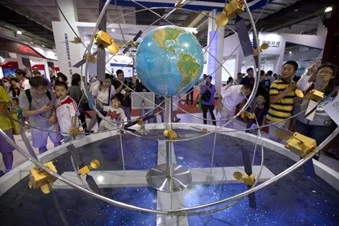Science and Technology
In News: China outlined plans to further expand global reach of its home-grown Beidou satellite navigation system.
- South Asia and Southeast Asia – both of which are key BRI regions – are a current focus of expanding Beidou’s presence.

About:
- Built as its alternative to America’s Global Positioning System (GPS).
- BDS has a “constellation” of 30 satellites in orbit.
- It began its international outreach once the set up was finished in 2018.
- Its application included use in guiding drones, autonomous cars, in agriculture and forestry, as well as launching with Chinese mobile phone companies, using Chinese chips, satellite-powered messaging for smartphones that provides for connectivity in remote areas even in the absence of ground reception.
- It is now in use “in more than half of the world’s countries”.
- Saudi Arabia is using Beidou in surveying and mapping, positioning people and vehicle in the desert
- Tajikistan is using BDS to monitor dams and lakes with precision.
- Lebanon is using BDS at Beirut port for marine survey and construction.
- In Burkina Faso, it is being used for survey and construction of hospitals.
- China and Russia have signed a strategic framework on their two navigation systems, taking forward a 2015 deal on interoperability between Beidou and GLONASS (Russia).
- Pakistan in 2014 became the first foreign country to set up a Beidou network.
- Beijing is strengthening regional cooperation with organisations such as ASEAN, the African Union, the League of Arab States, and the Community of Latin American and Caribbean States.
- For ASEAN, Beidou has set up a first of three Continuously Operating Reference Stations (CORS) for its network in Thailand in 2013.
- China and Sri Lanka also agreed plans to set up 10 CORS. CORS in Thailand and Sri Lanka will extend the BDS coverage at least 3,000 km more towards Southeast Asia and South Asia.
- China is also helping several BRI partners, including Pakistan and Sri Lanka, launch communication satellites.
Other countries navigation systems:
- GPS (USA)
- Galileo (Europe)
- GLONASS (Russia)
- QZSS or Quasi-Zenith Satellite System (Japan)
- Korea Positioning System
MUST READ NAVIC (India)
Source: The Hindu
Previous Year Question
Q.1) With reference to the Indian Regional Navigation Satellite System (IRNSS), consider the following statements: (2018)
- IRNSS has three satellites in geostationary and four satellites in geosynchronous orbits.
- IRNSS covers entire India and about 5500 sq. km beyond its borders.
- India will have its own satellite navigation system with full global coverage by the middle of 2019.
Which of the statements given above is/are correct?
- 1 only
- 1 and 2 only
- 2 and 3 only
- None














